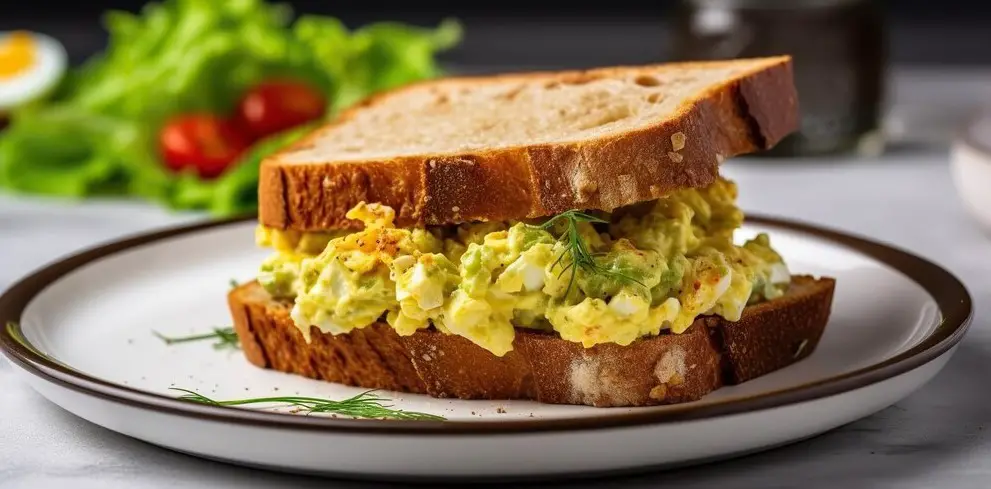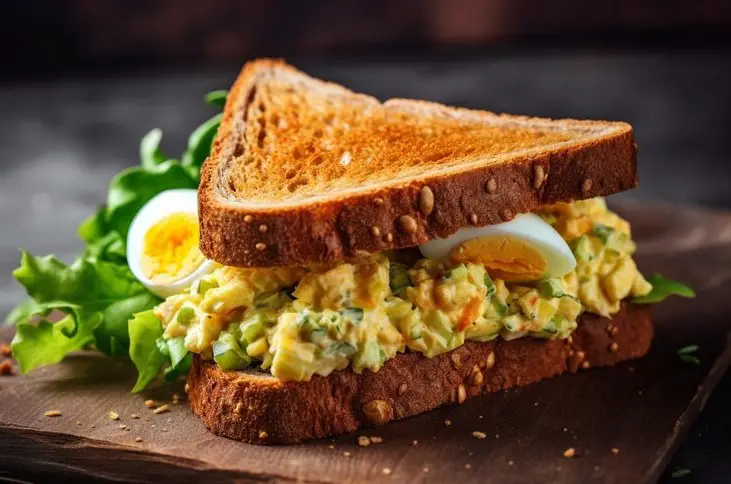Introduction to Scrambled Egg Sandwiches
Introduction to the Dish
A scrambled egg sandwich is more than just a simple breakfast option; it’s a canvas of culinary creativity. This dish, at its core, involves softly scrambled eggs nestled between slices of bread. However, its simplicity belies its appeal. The key to its charm lies in its versatility – it can be as straightforward or as elaborate as one desires. Whether it’s a hurried weekday morning or a leisurely weekend brunch, the scrambled egg sandwich fits perfectly into any mealtime scenario. Its ingredients are humble: eggs, bread, and a touch of butter or oil for cooking the eggs. Yet, with these basic components, one can create a meal that is both satisfying and delicious, making it a beloved choice for many.
Cultural Significance and Popularity
The scrambled egg sandwich transcends cultural boundaries, finding a place in various cuisines across the globe. Its popularity is a testament to its adaptability; it can be found in the bustling streets of New York as a breakfast staple, in a quaint English café as a tea-time snack, or even in an Asian bistro with a twist of local flavors. This dish’s universality is also reflected in its ability to bring people together, often being a first choice for a comforting homemade meal. It’s not just food – it’s a symbol of comfort, a reminder of home, and a representation of the idea that the simplest things are often the most satisfying. The scrambled egg sandwich, in its essence, is a celebration of simplicity and the joy of cooking something that is both easy and delightful. For more insights into diverse egg recipes and their cultural significance, explore Egg Cooking Techniques.
Ingredients and Variations
Basic Ingredients for a Classic Scrambled Egg Sandwich
The classic scrambled egg sandwich starts with the most fundamental ingredients: eggs, bread, and butter. The eggs, the star of the dish, are whisked until smooth, seasoned with salt and pepper, and then gently cooked in melted butter over low heat. This method ensures they remain soft and fluffy. The choice of bread can vary, but typically, a sturdy variety like whole wheat or white bread is used, lightly toasted to add texture and warmth. The butter not only aids in cooking the eggs but also adds a rich, creamy flavor. Some might add a splash of milk or cream to the eggs for extra richness. This basic recipe serves as a foundation, offering a comforting and satisfying sandwich that is both easy to make and delightful to eat.
Variations in Ingredients and Toppings
The beauty of a scrambled egg sandwich lies in its versatility. Here are some popular variations:
- Cheese: Adding cheese such as cheddar, Swiss, or pepper jack can elevate the sandwich with a gooey, melty texture.
- Meats: Ham, bacon, or sausage can be included for a hearty, protein-packed meal.
- Vegetables: Spinach, tomatoes, bell peppers, or onions can be added for extra flavor and nutrition.
- Herbs and Spices: Incorporating herbs like chives, parsley, or spices like paprika can add a new flavor dimension.
- International Flavors: For a unique twist, ingredients like avocado, salsa, or sriracha can give the sandwich a global flair.
Healthy and Dietary Alternatives
For those seeking healthier or dietary-specific options, there are plenty of alternatives:
- Bread: Opt for whole grain or gluten-free bread for added fiber and health benefits.
- Eggs: Use egg whites or a plant-based egg substitute for lower cholesterol and fat content.
- Low-fat Options: Low-fat cheese and skim milk can reduce calorie intake without compromising taste.
- Vegetables: Load up on veggies like spinach, mushrooms, or tomatoes for a nutrient-rich meal.
- Lean Proteins: Incorporate lean meats like turkey bacon or chicken sausage for protein without the extra fat. These alternatives ensure that the scrambled egg sandwich remains an inclusive dish for various dietary preferences and health considerations.
For a range of healthy breakfast ideas that can complement your scrambled egg sandwich, check out Healthy Breakfast Options.
Cooking Techniques
Step-by-Step Cooking Guide
Creating the perfect scrambled egg sandwich involves a few simple but crucial steps:
- Preparation: Begin by cracking fresh eggs into a bowl. For a classic sandwich, use two eggs per sandwich. Add a pinch of salt and pepper, and if desired, a splash of milk for creaminess.
- Whisking: Vigorously whisk the eggs until the yolks and whites are fully combined and the mixture is slightly frothy. This introduces air, making the eggs fluffier.
- Cooking the Eggs: Heat a non-stick skillet over medium-low heat. Melt a tablespoon of butter, ensuring it coats the entire surface. Pour in the eggs and let them sit undisturbed for a moment until they begin to set at the edges.
- Scrambling: Gently stir the eggs with a spatula, pushing them from the edges to the center. Continue this process, cooking slowly, until the eggs are softly set but still slightly runny; they will continue to cook from residual heat.
- Final Touch: Remove the eggs from the heat when they are still a bit wet. Overcooking can make them tough and dry.
Tips for Perfect Scrambled Egg Sandwich
- Low and Slow: Cook eggs on low heat to avoid overcooking. This ensures they remain tender and moist.
- Continuous Stirring: Gently stir the eggs throughout cooking. This creates small, soft curds rather than large, tough ones.
- Don’t Overcook: Remove the eggs from the heat when they’re still slightly runny. They’ll finish cooking with the residual heat.
- Freshness Counts: Use fresh eggs for the best flavor and texture.
- Seasoning: Season the eggs with salt and pepper before cooking to enhance their natural flavor.
Toasting and Assembling the Scrambled Egg Sandwich
- Toasting the Bread: Toast the bread slices to your preferred level of crispiness. This not only adds texture but also prevents the bread from becoming soggy from the eggs.
- Assembling: Place the scrambled eggs onto one slice of toast. If you’re adding cheese, place it on top of the hot eggs so it melts. Add any other desired toppings like cooked bacon, sliced avocado, or fresh herbs.
- Serving: Top with the second slice of toast. Cut the sandwich in half for easier eating, if desired. Serve immediately while warm and enjoy the delightful combination of flavors and textures in your homemade scrambled egg sandwich.
Discover more about perfecting your breakfast with our guide on Buttermilk for French Toast.
Serving and Pairing
- Serving Suggestions: Serve hot, garnished with fresh herbs or a side of salad.
- Pairing with Drinks and Sides: Complement with orange juice, coffee, or a light salad. Enhance your breakfast experience with our delicious Banana Waffle Recipe.
Nutritional Information About Scrambled Egg Sandwich
Caloric and Nutritional Breakdown
The nutritional content of a scrambled egg sandwich can vary based on the ingredients used. Generally, a basic sandwich with two eggs, butter, and white bread contains approximately 300-400 calories. It’s a good source of protein, essential for muscle repair and growth, providing about 20 grams per serving. The eggs also offer vitamins D and B12, phosphorus, and riboflavin. If you add cheese or meats like bacon, the calorie and fat content will increase, while using whole grain bread can add fiber to the meal.
Discussing the Health Benefits of Scrambled Egg Sandwich
Eggs, the primary ingredient in a scrambled egg sandwich, are highly nutritious. They are an excellent source of high-quality protein and contain a range of essential nutrients, including vitamin D, which is vital for bone health and immune function, and choline, important for brain health. When paired with whole grain bread, the sandwich becomes a good source of dietary fiber, beneficial for digestive health. By incorporating vegetables or opting for low-fat ingredients, the sandwich can be part of a balanced diet, offering a combination of proteins, carbohydrates, and healthy fats.
FAQs
Q: What are the best bread types for a scrambled egg sandwich?
A: The best bread for a scrambled egg sandwich depends on personal preference. Classic choices include white, whole wheat, and sourdough. For a richer flavor, brioche or ciabatta are excellent options. Those looking for healthier alternatives might opt for whole grain or multigrain bread.
Q: Can scrambled egg sandwiches be made in advance?
A: Yes, scrambled egg sandwiches can be prepared in advance. However, for the best taste and texture, it’s recommended to consume them fresh. If you need to make them ahead of time, store the scrambled eggs and bread separately and assemble the sandwich when ready to eat.
Q: How can I make my scrambled egg sandwich more flavorful?
A: To enhance the flavor, consider adding ingredients like cheese, herbs (such as chives or parsley), spices (like paprika or black pepper), or condiments (such as hot sauce or mustard). Including cooked meats like bacon or ham, or vegetables like spinach or tomatoes, can also add depth to the sandwich.
LSI and NLP Keywords
- Egg recipes, breakfast sandwich, quick meals, healthy breakfast, egg cooking methods, sandwich ideas, brunch recipes, egg and cheese, toast variations, gourmet sandwiches, meal prep, comfort food, dietary options, vegetarian sandwich, protein-rich breakfast.
Conclusion
In conclusion, the scrambled egg sandwich stands as a testament to culinary simplicity and versatility. From its basic form of fluffy eggs nestled between slices of bread to more elaborate versions with various toppings and flavors, this dish caters to a wide array of tastes and dietary preferences. It’s not only a quick and satisfying meal but also a canvas for creativity in the kitchen. Whether you’re seeking a hearty breakfast, a light lunch, or a nutritious snack, the scrambled egg sandwich is a delightful choice that combines taste, nutrition, and convenience in every bite. For more culinary delights, explore our Ultimate Guide to Pancake Tacos.



